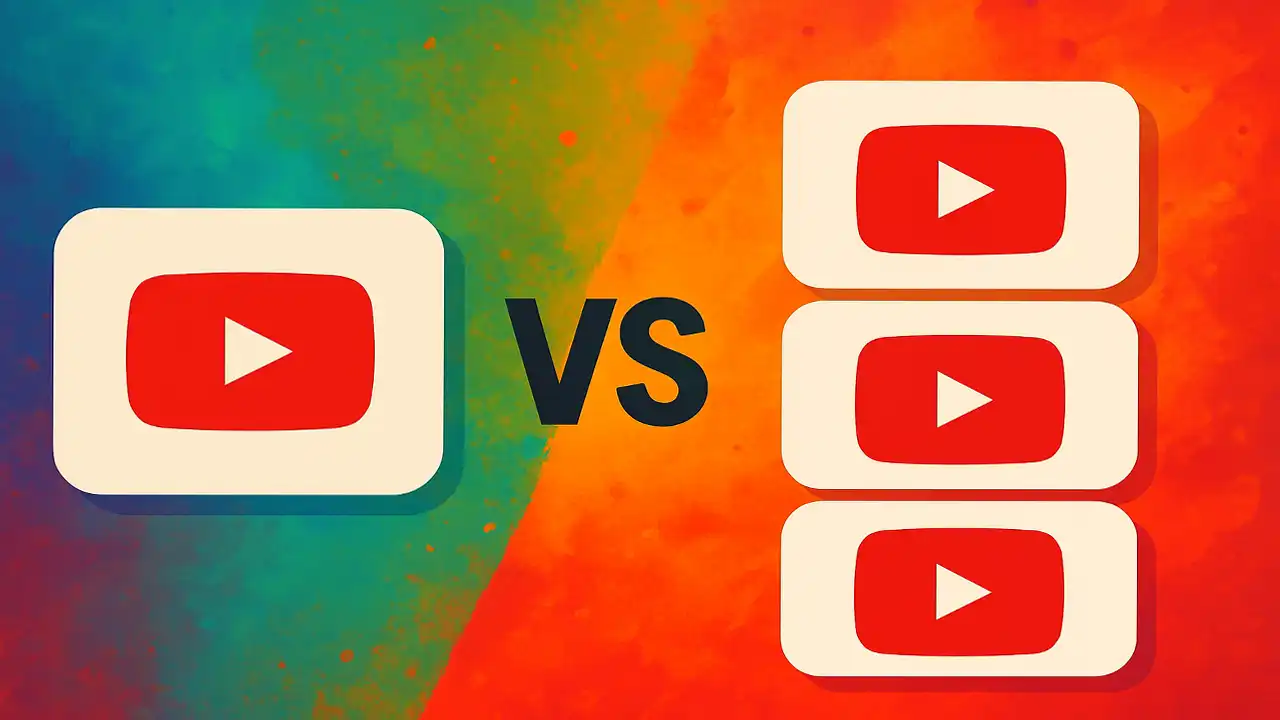Explore whether to run one YouTube channel or multiple. Discover pros, cons, SEO tips, and strategies for managing and growing your content effectively.
One YouTube Channel vs Multiple Channels Pros and Cons of Splitting Your Content

Why Choosing Between One or Multiple YouTube Channels Matters
For content creators on YouTube, one of the most critical decisions is whether to manage a single channel or split content across multiple channels. This choice significantly affects your brand identity, audience retention, growth strategy, and most importantly—your discoverability on YouTube and Google.
With over 2 billion monthly logged-in users, YouTube remains a dominant platform for video content. The way you structure your content plays a crucial role in both audience engagement and search engine visibility. Should you house all your content under one roof or diversify into niche-specific channels? In this guide, we’ll break down the pros and cons of each approach, and offer actionable tips to help you make the best choice for your channel strategy.
Primary Keywords: One YouTube Channel vs Multiple Channels, YouTube content strategy, YouTube SEO
Long-tail Keywords: Should I split my YouTube content, YouTube multiple channels benefits, managing several YouTube channels
Comprehensive Overview: One Channel vs Multiple YouTube Channels
The One-Channel Strategy
A single YouTube channel allows creators to build a unified brand where all types of content—whether it’s vlogs, tutorials, reviews, or educational material—coexist. This strategy suits creators with a diverse personality or those who are still experimenting with their niche.
Advantages of One Channel:
- Simplified Management: One dashboard, one analytics stream, one monetization setup.
- Stronger Subscriber Base: All subscribers get notified regardless of the content type, increasing exposure.
- Faster Growth Potential: New videos benefit from the momentum of existing subscribers and higher watch time.
Disadvantages of One Channel:
- Audience Confusion: Viewers might be disinterested in content that doesn’t match their preference.
- Diluted SEO Impact: YouTube and Google may struggle to categorize your channel’s purpose.
Lower Click-Through Rate (CTR): Mixed content can reduce video relevance for your audience.
The Multi-Channel Strategy
Creating multiple niche-focused channels means each channel targets a specific audience segment, enhancing clarity and relevancy.
Advantages of Multiple Channels:
- Better SEO Targeting: Each channel can be optimized for different sets of keywords.
- Audience Relevance: Subscribers get exactly what they expect—leading to higher engagement and retention.
- Brand Authority in Niches: Easier to establish thought leadership in specific areas.
Disadvantages of Multiple Channels:
- More Management Complexity: Each channel requires separate branding, uploads, thumbnails, analytics, and community management.
- Slow Initial Growth: New channels start from scratch with no subscribers or watch hours.
- Resource-Intensive: Time and energy are divided, requiring more effort to maintain consistency.
Practical Tips and Techniques: How to Decide What Works for You
1. Analyze Your Audience Behavior
Use YouTube Analytics to study viewer demographics, behavior, and preferences. If certain videos perform significantly better or attract different viewer segments, splitting may make sense.
2. Define Your Core Content Pillars
If your content fits naturally into 2–3 clear categories that don’t overlap in audience interest, consider creating multiple channels. Example:
- Main Channel: Personal branding and lifestyle
- Secondary Channel: In-depth tutorials or niche topics
3. Maintain Branding Consistency
If you choose multiple channels, keep branding elements like logos, fonts, intros, and tone consistent to reinforce brand recognition across platforms.
4. Cross-Promote Strategically
Use one channel to drive traffic to another. Pin comments, mention channels in videos, or use end screens and cards to promote related content.
SEO Optimization: How to Rank Your Channel(s) on Google and YouTube
A. Keyword Research
Use tools like TubeBuddy, VidIQ, or Google Keyword Planner to find niche-specific long-tail keywords. Optimize:
- Channel descriptions
- Video titles
- Tags and playlists
- About section
B. Optimize Metadata
For each video:
- Use compelling titles with your main keyword
- Write a 150+ word description with keyword variations
- Include timestamps and internal links to other videos
- Use 5–15 relevant tags
C. Alt Text for Images and Thumbnails
Although YouTube doesn’t allow alt text directly, your video file name and thumbnail image name should include keywords, e.g., youtube-multiple-channels-strategy.jpg.
Images and Their Optimization for YouTube SEO
High-quality thumbnails dramatically affect your CTR. Here’s how to optimize:
- Use 1280x720 resolution for thumbnails.
- Keep designs clean and text readable even on mobile.
- Use descriptive file names: best-youtube-channel-strategy.png
- Alt Text (for your site or blog): “Choosing between one or multiple YouTube channels for content growth”
Use tools like Canva or Fotor to design consistent, branded thumbnails.
Internal and External Linking Best Practices
Internal Links:
If your YouTube content is embedded on your website or blog, link to:
- Related articles (e.g., “Top YouTube SEO Techniques for 2025”)
- How-to guides
- Category pages (Tag Generator)
External Links:
Cite reputable sources such as:
- YouTube Creator Academy
- Google’s Search Central Blog
Conclusion: Which Strategy Should You Choose?
Choosing between a single or multiple YouTube channels depends on your goals, content variety, and available resources. Here’s a quick summary:
| Strategy | Best For |
|---|---|
| One Channel | Personal brands, small teams, lifestyle creators |
| Multiple Channels | Niche marketers, businesses, educators, agencies |
No matter which path you choose, the key is consistency, relevance, and optimization. Align your content with your audience’s expectations and back it up with smart SEO strategies.
Sustainable Improvement: Keep Optimizing!
To ensure long-term success:
- Regularly review analytics for performance shifts
- Experiment with A/B testing thumbnails and titles
- Update older videos with improved descriptions or links
- Monitor keyword trends and adapt your content strategy
SEO and content management on YouTube are not one-time tasks—they’re evolving processes. Stay updated with YouTube’s algorithm changes and be ready to pivot your strategy accordingly.